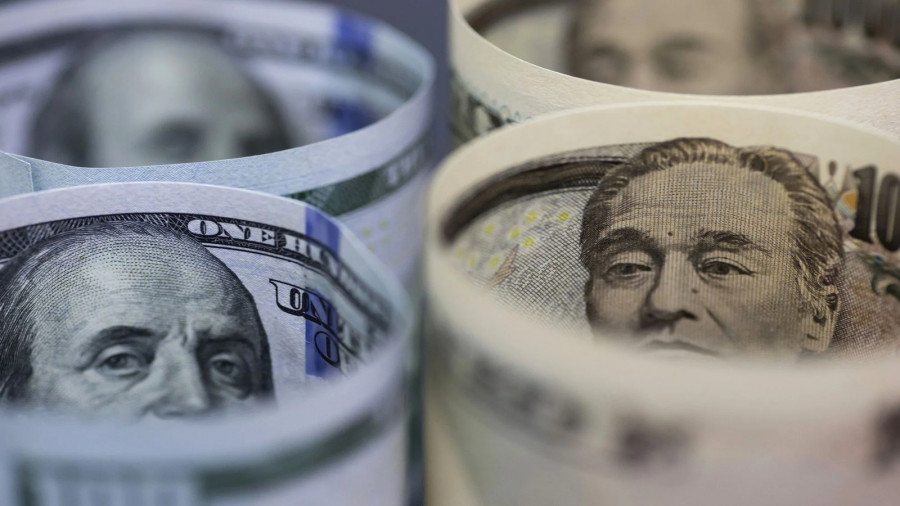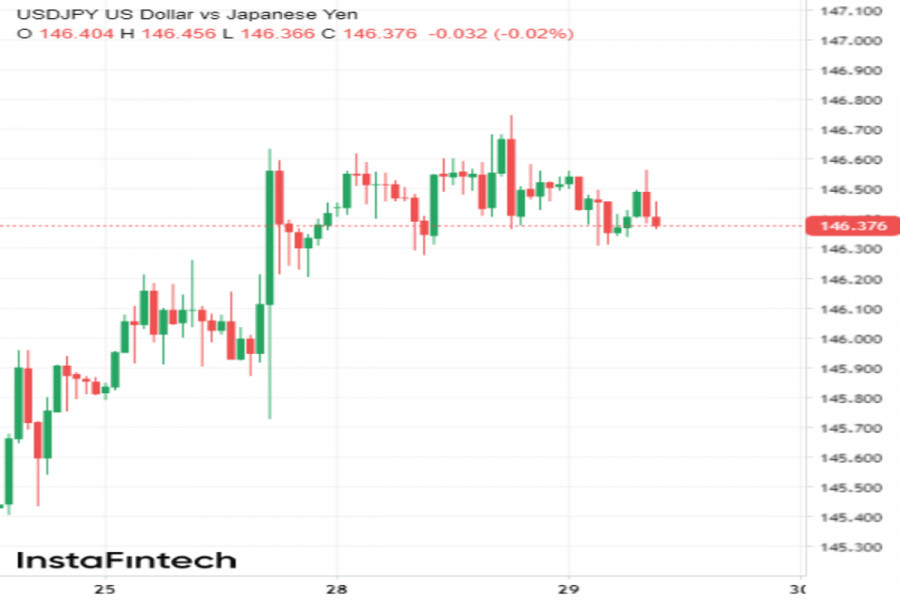

At the start of the week, the tug-of-war between the US dollar and the yen intensified noticeably, resulting in the ongoing consolidation of the currency pair. On Tuesday morning, the pair continued to trade without a clear direction, but this is unlikely to last for long. Many experts predict a breakout of the current sideways channel in the near term. Let's figure out who will ultimately stay on top: the dollar or the yen.
What is driving the US dollar?Yesterday, USD tested a fresh multi-month high against its Japanese counterpart. The USD/JPY pair surged to its highest level since November 9, 2022, at 146.75. However, it couldn't quite hold onto its peak position. By the end of the session, the quote had settled at 146.50, managing to add just 0.05% in the course of the day.

The main driving force behind the pair's rally remains the stark divergence in monetary policies between the United States and Japan. This is how the yen has already seen a 10% depreciation against the dollar this year. If the gap in interest rates between these two countries continues to widen, the pair could face even steeper declines.
At the moment, the key interest rate in the US ranges between 5.25% and 5.50%, whereas in Japan, it stays in negative territory at -0.1%.
According to forecasts from futures traders, the Federal Reserve is likely to maintain its key interest rate in September. However, there is a strong likelihood of a 0.25% rate increase in November. Traders currently assess the odds of additional tightening measures in the US at over 60%, a significant shift from 42% just a week ago.
The reinforcement of hawkish sentiments regarding the Fed's future monetary policy was bolstered by recent remarks from Jerome Powell, the head of the US central bank.
Speaking last Friday at the economic symposium in Jackson Hole, the Fed Chair assured markets that the central bank would proceed with utmost caution in the future. However, he did not rule out the possibility of further rate hikes in the US, citing the continued high inflation levels in the country.
"Jerome Powell's hawkish language signals that the prevailing risks are leaning towards continued tightening and a later initiation of the easing cycle. This creates a favorable environment for the dollar," observed Carol Kong, a currency strategist at the Commonwealth Bank of Australia.
Conversely, for the yen, the fundamental landscape remains pessimistic. Last Saturday, Bank of Japan Governor Kazuo Ueda participated in a panel discussion at the economic forum in Jackson Hole where he explained BOJ's cautious stance by persistently low core inflation.
"As long as the Bank of Japan sticks to its dovish stance while the Fed continues its hawkish trajectory, the yen is expected to weaken further against the US dollar," stated analysts at Goldman Sachs.
According to their forecast, the USD/JPY pair is anticipated to strengthen to its highest level since June 1990, reaching 155 over the next six months. Previously, they projected that the yen would be trading against the dollar at around 135.
Nevertheless, not all experts are currently as optimistic regarding the dollar/yen pair. There is a prevailing viewpoint that, in the medium term, USD/JPY could encounter several obstacles that could limit its growth.
What supports the yen?Despite the fact that the current fundamental landscape is clearly not favoring the Japanese currency, the yen still manages to muster the strength to resist the dollar's pressure and avoid a freefall.
One of the key factors supporting JPY is the risk of intervention. It is worth recalling that the yen is currently trading at levels that prompted the Japanese government to step into the market last year.
Traders are concerned that a further substantial decline in the Japanese currency could prompt Tokyo to press the intervention button once again. In such a scenario, the USD/JPY pair may enter a sharp nosedive.
Another factor that currently aids the yen in maintaining a fragile balance against the greenback is the rise in speculations about an impending monetary shift by the Bank of Japan (BOJ).
Despite the BOJ Governor persistently echoing a dovish mantra, some market participants are still placing their bets on the regulator taking a more hawkish stance in the coming months.
The reinforcement of hawkish sentiment towards BOJ was fostered by yesterday's report from the Japanese government. Last Monday, authorities announced that after a 25-year struggle against deflation, the country is finally nearing a turning point in terms of inflationary conditions.
The document indicates that price and wage growth have been observed in Japan since spring 2022, a stark contrast to BOJ's statements about the transient nature of inflation.
"The current stance of the Bank of Japan on prices is incorrect as it does not align with reality," stated former BOJ governor candidate Tsutomu Watanabe.
A professor at the University of Tokyo believes that the BOJ is not ready to abandon its ultra-loose monetary policy at this stage, so it presents inflation in such a light.
Had BOJ confirmed the sustainability of price growth, this would immediately trigger a surge in speculations about possible interest rate hikes, causing market turbulence.
Certainly, the Bank of Japan cannot turn a blind eye to rising inflation for too long. Sooner or later, it will have to acknowledge this issue and take its first step towards a hawkish direction.
According to Tsutomu Watanabe, a complete abandonment of the yield curve control policy should be the first step in this direction. This move may not be far off, considering recent changes in the Yield Curve Control (YCC) approach.
By dismantling the yield curve control mechanism, the regulator will effectively pave the way for normalizing its monetary policy.
Watanabe predicts that the Bank of Japan will initiate its first interest rate hike at the beginning of the coming year, signaling the end of the era of a weak yen.
Weekly outlook for USD/JPYIn the coming days, traders engaged in USD/JPY trading will need to digest a slew of economic data from the United States. The most crucial among them include:
-The JOLTS report on job openings in the trade, manufacturing, and office sectors.
-The Consumer Confidence Index by the Conference Board (CB).
-The ADP employment change report for the nonfarm sector.
-GDP statistics for the second quarter.
-The core Personal Consumption Expenditures (PCE) index.
The primary trigger this week should be the Nonfarm Payrolls report on Friday. It is expected to induce high volatility across all major dollar pairs and potentially shift the USD/JPY pair from its standstill.
"Stronger-than-anticipated employment data could intensify market expectations for an additional round of tightening by the Fed and push the dollar higher across the board," remarked CBA analyst Carol Kong.
According to analysts at UOB, by the week's end, the greenback could potentially strengthen to 147.50 against the yen.